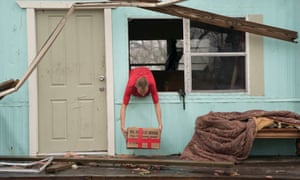
A man removes some possessions from his home in the aftermath of Hurricane Harvey. ‘With storm surge and heavy rainfall increasing and climate and sea level rise, the system is just not working,’ says a flood risk analyst.
Photograph: Darren Abate/EPA
How climate change could turn US real estate prices upside down
Floridians have long recognised climate’s threat to their homes. Amid the disaster wrought by Harvey, home buyers may look to higher ground
If Florida gleaned anything from Hurricane Andrew, the intensely powerful storm that tore a deadly trail of destruction across Miami-Dade County almost exactly 25 years to the day that Hurricane Harvey barrelled into the Texas coastline, it was that living in areas exposed to the wrath of Mother Nature can come at a substantial cost.
At the time the most expensive natural disaster ever to hit the US, Andrew caused an estimated $15bn in insured losses in the state and changed the way insurance companies assessed their exposure to risk for weather-related events.
Many of the lessons that Florida has learned since 1992 have parallels in the unfolding disaster in Texas, experts say, and what was already a trend toward factoring in environmental threats and climate change to land and property values looks certain to become the standard nationwide as Houston begins to mop up from the misery of Harvey.
“The question is whether people are going to be basing their real estate decisions on climate change futures,” said Hugh Gladwin, professor of anthropology at Florida International University, who says his research suggests higher-standing areas of Miami are becoming increasingly gentrified as a result of sea level rise.
“In any coastal area there’s extra value in property, [but] climate change, insofar as it increases risks for those properties from any specific set of hazards – like flooding and storm surge – will decrease value.”
Miami Beach in particular has become a poster child for the effects of climate change, with some studies making grim predictions of a 5ft sea level rise by the end of the century and others suggesting that up to $23bn of existing property statewide could be underwater by 2050.
To counter those effects and preserve property values, Miami Beach has embarked on an ambitious and costly defensive programme that includes raising roads and installing powerful new pumps to shift the ever more regular floodwaters.
Even so, there are indications that investors are already looking to higher ground elsewhere in the city, such as the traditionally poor, black neighbourhoods of Little Haiti and Liberty City. “The older urban core was settled on the coastal ridge and anything below that was flooded. The coastal ridge we’re talking about is clearly gentrifying,” Gladwin said.
Or, as the journal Scientific American put it in its own investigation in May: “Real estate investment may no longer be just about the next hot neighbourhood, it may also now be about the next dry neighbourhood.”
Other analysts cite recent storms including Harvey, as well as Sandy, which wrecked areas of New Jersey and New York in 2012, as evidence.
“You have folks in south Florida buying houses in North Carolina and Tennessee, because they like the scenery but also because it’s high ground. If south Florida drops off into the ocean, they’ll have a place to go,” said Andrew Frey, vice-chairman of the south-east Florida/Caribbean Urban Land Institute and a Miami real estate developer.
“The more frequent these volatile superstorms become, the more people will look to build in safer places. If seas are rising three millimetres a year that’s one thing, but if we’re getting superstorms every couple of years with greater frequency and intensity, things can change a lot faster.”
Such concerns have fuelled demand for data-driven analysis and climate aggregation services that offer real estate advice to clients ranging from large corporations, state and local governments to farmers and individual house buyers.
One such number-crunching company, the San Francisco-based Climate Corporation, which collates and analyses National Weather Service data mostly for clients in agriculture, has previously warned that it would take only “a few climatic events in a row” for a collapse in property values “that will make the housing crisis [of 2008] look small”.
Its assessment is backed by Albert Slap, president and co-founder of Coastal Risk Consulting, a Florida firm that provides flood risk analysis reports. Slap said Harvey was only the latest natural disaster to expose flaws in the national flood insurance programme allowing property owners in the Federal Emergency Management Agency’s so-called Zone X – areas at risk of a once-in-500-years flood event – not to carry coverage or fully disclose their flood risk when they sell.
“With storm surge and heavy rainfall increasing and climate and sea level rise, the system is just not working,” he said.
“Millions more people need flood insurance than have it and the crazy thing about Houston was only 15% of those who were flooded had flood insurance. The risk communication is not enough.
“You have thousands of properties in Norfolk, Annapolis, Atlantic City, Savannah, Charleston and Miami Beach where part of the property goes underwater with seawater for days at a time. When you have fish swimming in your driveway, it’s not an amenity, like a swimming pool. It means you’re driving through saltwater to get your kids to school, get to the supermarket, whatever you’re going to do.
“Will there be a massive decline in the property values of the flooded areas in Houston? Common sense would say yes. And if that’s combined with new legislation that’s going to require full disclosure, then wow.”










